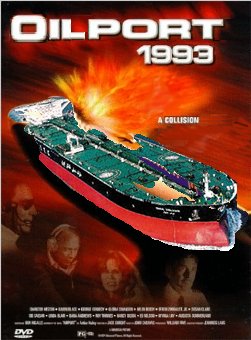 A mishap during the loading of an oil tanker off Saudi Arabia in 1993 initiated a cascading disaster, resulting in what was the largest offshore oil spill ever, but the oil was mostly recovered by deploying supertankers to vacuum up the spill. This is the story told by a former Saudi Aramco engineer in concert with his efforts to convince BP and the U.S. Coast Guard to consider this approach for cleaning up the recent oil spill in the Gulf of Mexico.
A mishap during the loading of an oil tanker off Saudi Arabia in 1993 initiated a cascading disaster, resulting in what was the largest offshore oil spill ever, but the oil was mostly recovered by deploying supertankers to vacuum up the spill. This is the story told by a former Saudi Aramco engineer in concert with his efforts to convince BP and the U.S. Coast Guard to consider this approach for cleaning up the recent oil spill in the Gulf of Mexico.
While the possibility of a spill-tested but presently ignored solution to the unfolding environmental mess is very intriguing, I was equally drawn to the fact that, if the story were true, Saudi Aramco had managed to keep this massive spill and its mostly-successful remediation a secret for over sixteen years. Not unexpectedly, Saudi Aramco has denied that this spill took place. Who is telling the truth?
Who cares! Start the movie!
Background: The Oils of War
The Arabian (or Persian) Gulf is not one of the more pristine bodies of water, given that it is the conduit for a good chunk of the world's oil and perforated at its rather shallow bottom with hundreds of wells. But what is currently believed to be the largest spill happened not as a result of an accident, but rather as war strategy. On January 16, 1991, Allied forces began bombing Iraq in preparation for the military reconquest of Kuwait. About 2-3 days later, Iraq began releasing oil from the Kuwait Sea Island terminal into the Arabian (Persian) Gulf. This spill was later augmented by oil from other sources including tankers and refineries. The oil flowed for about 10 days, and although the total amount of oil spilled is not precisely known, and EPA estimate of 6 million barrels makes this the largest oil spill on record, surpassing the 3.5 million barrels Ixtoc Gulf of Mexico spill in 1980.
Given the direction of water flow in the Arabian Gulf, the shores of Saudi Arabia bore the brunt of the spill:
The largest oil spill in the history of the Gulf hit 700 kilometers (435 mi) of Saudi Arabia’s coastline during the 1991 Gulf War. As it drifted south, the oil sank into wet sands and formed layers of tar that poisoned the breeding grounds of fish and crustaceans. Teams from Saudi Aramco worked around the clock to protect vital water-intake channels used for power generation, desalination and injection, and they recovered more than 1.2 million barrels of oil—the largest amount ever collected from a spill—thus sparing hundreds of kilometers of beaches and intertidal areas.
Years later, the environmental effects were still being assessed all over the Gulf. Studies continued for many years, many scientific papers were published, and oil companies developed emergency spill response plans to handle such situations. But according to one report, an even bigger spill happened sometime in 1993, but nobody told anybody who was still fretting over the previous largest spill.
Déjà vu, Oil Over Again
In Esquire Magazine's The Politics Blog, former Shell Oil President John Hofmeister was being interviewed by writer Mark Warren about BP's response to the current crisis when he said this:
JH: The work going on to close the well is taking multiple approaches, and I am aware that BP has sent out a message to all the oil companies asking for help and advice. And I actually sent some people to BP in terms of the spill response cleanup to try to get them aware of a process that has been used in the Arabian Gulf that has not been used in the Gulf of Mexico, and that is to use supertankers, empty supertankers, to suck up the oil off the surface, where they can store the oil, they can treat the water, they can discharge the water and then they can either salvage the oil or destroy it, as the case may be. And I know the mayor of New Orleans and a few other officials are now asking BP about that process as a result of these engineers coming forward from Saudi Aramco.ES: When did that spill happen, John?
JH: I don't actually know, but it was sometime back, there was a huge, huge spill that never got reported, because they don't have an open press, obviously... But I was told it was a 700-million-gallon spill.
ESQ: That would be the biggest, right?
JH: That would be the biggest the world has ever known. And they used six supertankers to clean up the oil and were very successful. We'd do well to get supertankers in the Gulf.
Hofmeister learned of the Saudi spill during the recent Offshore Technology Conference in Houston in a conversation with Nick Pozzi, who was employed by Saudi Aramco and had first hand knowledge of the cleanup (although not the incident itself). Pozzi and his current business partner, attorney Jon King, have been trying to persuade BP to consider the strategy that seemingly worked on a much larger spill in 1993.
Warren next contacted Pozzi and King and they gave further details of the Saudi spill and cleanup effort.
The primary equipment that was used to remove the crude from the Arabian Gulf was Super Tankers. The Super Tankers were used to store everything, run thru on-shore three-phase separators and sent to on-shore tank farms for additional clean up using centrifuges. The more the oil spreads the more tankers will be needed. Nick would be willing to provide a conceptual non-technical drawing to visualize this process.
Also at the above link is video from the NBC Today show with an interview of Hofmeister.
Oil Port 1993
The thought of six supertankers meandering around slurping up oil like whales feeding on krill invokes wonder. Further details on the incident itself are revealed in a story from AOLNews:
The 1993 Persian Gulf spill, Pozzi says, began when Aramco was loading a tanker and "the umbilical cord got away." Oil started spewing from the pumps. Panicked, a line of tankers waiting to be filled began hightailing away from the flammable spray. Massive ships maneuvered in tight quarters. It was chaos.
Because of a confidentiality agreement with Aramco, Pozzi won't describe exactly what happened next, except to say that "there were [then] other mishaps causing other oil to spill."
"The order of magnitude rose exponentially due to the panic level," he says.
The Politics Blog also had this:
The suck-and-salvage technique was developed in desperation across the Arabian Gulf following a spill of mammoth proportions — 700 million gallons — that has until now gone unreported, as Saudi Arabia is a closed society, and its oil company, Saudi Aramco, remains owned by the House of Saud. But in 1993 and into '94, with four leaking tankers and two gushing wells, the royal family had an environmental disaster nearly sixty-five times the size of Exxon Valdez on its hands, and it desperately needed a solution.
To recap the sequence of events, what we have so far is:
- A tanker is loading crude while several (at least three) additional tankers are waiting in line
- The "umbilical cord" feeding the tanker is dislodged, spewing crude oil into the water
- The tankers begin scrambling to move away from the oil
- In the ensuing panic, four tankers end up leaking oil and two wells are somehow uncorked.
- 700 million gallons of oil is eventually spilled, with 85% of it collected over six months using supertankers as giant wet/dry vacuums.
- Oil is offloaded to onshore gas oil separation plants.
Assuming these details are accurate, the following questions come to mind:
- When did the spill happen?
- Where could this spill have happened?
- Could that much have been spilled?
- Where did the tankers used to collect the oil come from?
- How would the oil be separated from the water?
- Is there any evidence of such a spill?
Alternately, all or part of the story could be fiction. Indeed, after several weeks, Saudi Aramco finally issued a flat denial.
Dhahran, June 22, 2010 -- Saudi Aramco unequivocally refutes allegations reported in several news media and Internet blogs about an alleged "secret" oil spill during 1993 in the Arabian Gulf. The Company states that there is no factual basis to those allegations, and there was no such event or incident as alleged concerning its operations in 1993, 1994, or at any other time. Saudi Aramco confirms that it participated in oil spill cleanup activities and operations in early 1991 during the Gulf Conflict. Under the leadership of Saudi Arabia’s government, the Company, together with various agencies, undertook oil spill cleanup operations lasting for about six months until July 1991. The Company’s response to the 1991 oil spill was carried out with the technologies and best practices available at that time, such as portable skimmers and containment booms.
Although the company utilized a number of work and supply boats, Saudi Aramco wishes to clarify that no supertankers were used during the 1991 spill cleanup operations. The concept of utilizing supertankers to collect large quantities of spilled oil was never pursued. The Company has made reports available to several news media outlets about Saudi Aramco’s involvement in the 1991 spill cleanup. One of the reports was published in Saudi Aramco’s Dimensions Magazine Fall 1996 edition and can be viewed at http://www.saudiaramco.com/irj/go/km/docs/SaudiAramcoPublic/ExternalFile... The Company also confirms that Mr. Nicholas Pozzi is a former employee and worked as a foreman in Saudi Aramco’s East-West Pipeline Department. However, he made no significant contribution to the Company’s spill preparedness or response teams during his employment or at any other time. The claims made about his alleged efforts at a 1993 oil spill response operation are without factual basis.
This seems rather unambiguous. Some might remain skeptical, however, as having to own up to this after so many years would be embarrassing. Would they lie?
The Motivation for Secrecy
Trying to understand the need for Saudi Aramco to keep such an incident secret is probably no easier than understanding their need to keep their oil production data secret. In my articles on various Saudi projects, I have noted several cases where they have clearly been less than forthcoming:
Many observers are skeptical about Saudi oil reserves claims as well as the status and oil production level of Ghawar, the world's largest oil field. While there are valid arguments to be made for more transparency, Saudi Aramco can also make valid claims of the need for secrets (for security reasons if nothing else). But an oil spill which could impact other counties coastlines (not to mention its ability to deliver oil to customers) would seem to fall into a different category. The coastline of Saudi Arabia suffered the most from the 1990 spill during the Gulf War:
The Gulf War Oil Spill Twelve Years Later: Consequences of Eco-Terrorism
What Happened To The GULF: Two Years After The World's Greatest Oil-Slick
On one hand, Saudi Aramco has allowed the documentation of many field-related problems in Society of Professional Engineers (SPE) publications. Indeed, Matt Simmons wrote Twilight in the Desert based on an analysis of many such papers. But there is also a curious, almost amateur, approach to the censuring of the papers of name and place data. Nevertheless, information eventually leaks out in some form. A concealment of this magnitude would seem to require a more foolproof approach and motivation.
On the other hand, Saudi Aramco doesn't really admit to any oil spills. From The Tankership Tromedy:
You can see that most of the CTX transfer spills are at the discharge port (activity codes L and d). I would not make much of this. Most load ports are in countries which, whether they are strict or lax, don’t make spills public. The CTX database has no spills at Ras Tanura/Juaymah by far the largest tanker load port in terms of volume. This port loads half-a-dozen big tankers a day. Based on my experience, I’d be surprised if this port averaged less than one spill a week, almost all of them quite small.
Checking Out the Story
Despite the rather emphatic denial by Saudi Aramco, I will look into the possibility of the spill, partly because some of you won't believe them, but also because it's fun. Back to the questions raised earlier:
1) When did the spill happen?
The account says the cleanup occurred from 1993 into 1994, spanning six months, so the spill would have happened in summer 1993.
2) Where could this spill have happened?
(This will take a bit longer to cover)
Most Saudi Arabian crude oil is loaded onto tankers at one of four separate locations: The main oil export terminal at Ras Tanura, the Al Juaymah offshore terminal about 20 miles northwest of Ras Tanura, a similar but smaller offshore terminal in the offshore Zuluf oil field, and the Yanbu terminal on the Red Sea (via pipeline), Below is a map showing the location of Ras Tanura along with those for the major Saudi offshore fields.
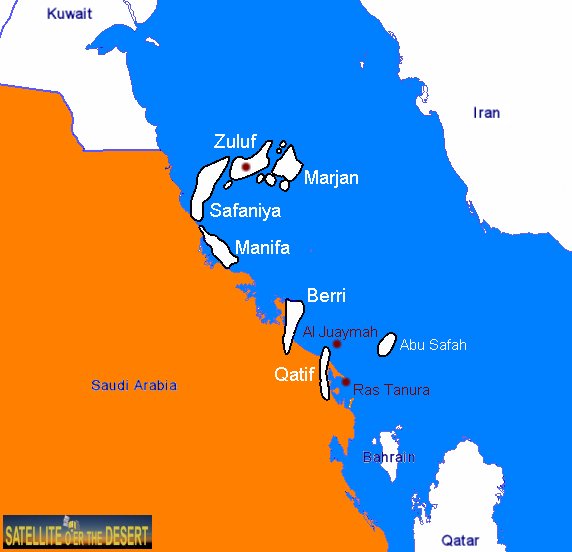 |
| Major Saudi Arabian Offshore Oil Fields. Oil export terminals are indicated with reddish dots. |
The largest oil exporting terminal in the world is located on the Ras Tanura peninsula and is capable of loading over 5 million barrels of oil per day onto tankers moored on one of two T-shaped terminals (small vessels only) or on one of a cluster of four Sea Islands located offshore in deeper water. The limit for tankers berthed at the Sea Islands is 550,000 dwt (dead-weight tons). Shown below is a satellite image of Ras Tanura seen in Google Earth (this image and those further below copyright Google and Friends).
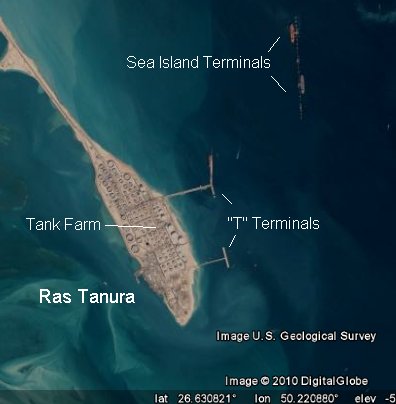 |
| Ras Tanura Oil Terminal, the world's largest. |
Below is a closeup of a tanker being loaded at one of the Sea Islands. Oil is delivered to the islands via underwater pipeline and pumped into the tankers via several Chiksan loading arms, or articulated steel pipes.
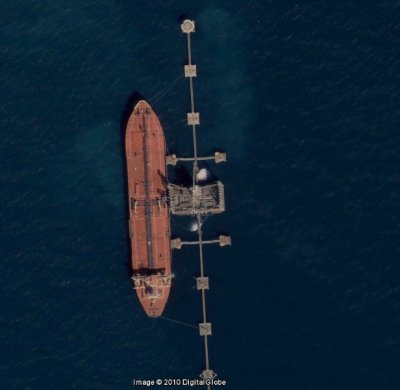 |
| Tanker loading at Ras Tanura Sea Island. |
Here is a video of a Chiksan gasoline loading operation gone awry.
The Al Juaymah Offshore Terminal is located to the northwest of Ras Tanura, just east of the Qatif oil field as shown below. The Qatif field lies both on and off shore, with several offshore platforms positioned to drill and maintain offshore wells. Oil is loaded onto tankers from Single Point Moorings (SPMs) anchored in deeper water such that larger ships can be handled (up to 700,000 dwt). It has been in operation since 1974. The Al Juaymah complex also includes a pier from which liquified natural gas (LNG) is loaded onto ships.
 |
| Al Juaymah Offshore Oil Terminal (Single Point Moorings) |
Oil is similarly delivered from shore in underwater pipeline to a platform, distributed to the SPMs and then transferred to the tanker via large flexible hoses connecting them to the SPM. There are six SPMs at Al Juaymah, which can theoretically output six million barrels per day and has been in operation as early as the 1970s. In a 2005 Google Earth satellite image, I can only find two SPMs, although others might be present in low resolution images.
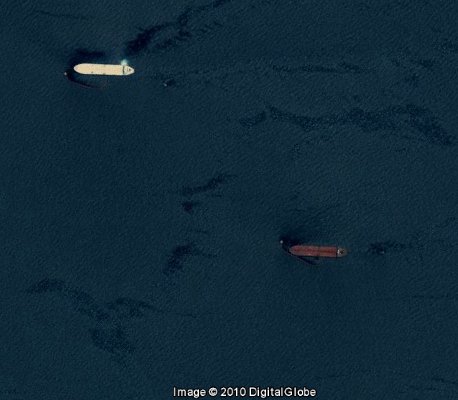 |
| Two tankers (separated by one mile) loading at Al Juaymah Single Point Moorings in 2005. These tankers are each just over 1000 feet in length. |
Shown below is a closeup of the darker tanker from above receiving oil. There are two "hoses" attached to this tanker, whereas there are three attached to the other.
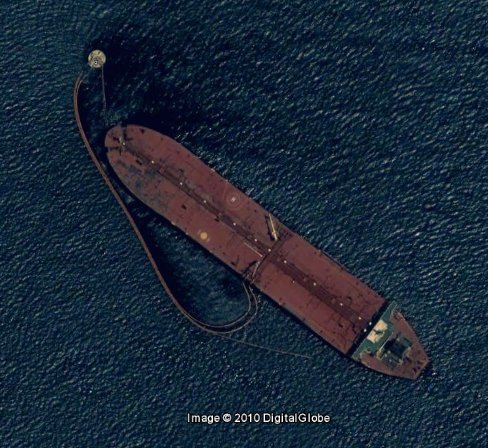 |
| Tanker loading at Al Juaymah Single Point Mooring. |
I haven't found anything recent on loading rates, although SPE 4013-MS suggests that each (in the late 1970s) was designed for a flow of at 130,000 barrels per hour but averaged only half that in practice.
The operational principle is that ships can rotate independently around the SPMs, orienting themselves to minimize crosswinds (the two tankers are pointing northwest, which is the direction that the wind normally comes from: down the Saudi shore). The Louisiana Offshore Oil Port (LOOP) in the Gulf of Mexico operates in the same way as Al Juaymah, albeit in reverse (oil is pumped out of the tankers).
Finally, the terminal at the Zuluf field, which reportedly ships oil from the Zuluf and Marjan fields, has only a single SPM. Unfortunately, there are no high resolution images available from Google Earth that might show whether this is still operational, and I haven't found any historical information, either.
3) Could that much have been spilled?
700 million gallons is a lot of oil. There were reportedly three sources:
- Oil from the terminal ("unbilical cord")
- Oil from leaking tanker(s)
- Oil from two "gushing" wells, damaged during the melee
The initial spill was from the supply hoses connected to the tanker being loaded. As seen in the video linked above of a Chiksan loader spewing gasoline, the flow rates can be quite high. This paper discusses tanker loading rates at the Al Juaymah terminal. In case of an accident, a lot of oil can flow in the near term, but there are many ways in which the flow could be stopped, from shutting valves to turning off pumps to just letting the storage tank run out. The amount spilled might be enough to incite immediate panic, but nothing approaching 700 million gallons.
The largest tankers can hold about 2 million barrels, or 84 million gallons. Four such supertankers leaking out all their oil would yield 336 million gallons. Now we're getting somewhere. However, with the exception of the one actually being loaded, the tankers were waiting to be loaded; i.e. they were empty of oil. Beyond that, it would seem that the only way the first tanker could have spilled a ship full of oil is if it was a) filled nearly full, and then b) sank.
This leaves the oil wells. The only realistic scenario would be for a tanker colliding with a platform connected to two or more wells. A problem is identifying platforms that could have actually been involved. There are no wells (or offshore platforms) near Ras Tanura. In contrast, as seen in a map from earlier, there are a few platforms near the Al Jumayah moorings (at least there are now -- Qatif was reworked in 2004, so those platforms might not have been there). However, the nearest of these are for water injectors. The water gets increasingly shallow further into the field (20 feet deep), so it is not clear that tankers would have been able to get there. This leaves only the Zuluf terminal as the only location consistent with the leaking well scenario.
Let's do a simple calculation and assume that of the 700 million gallons (around 17 million barrels) 2 million leaked from the ship(s) and terminal, and that the remaining 15 million barrels flowed out at a constant rate from two wells for six months. This translates to over 40 thousand barrels per day per well. Now, a deepwater GOM well might do this due to the much higher pressure, but the reservoir pressures for offshore Saudi fields do not support this kind of rate, and certainly not for an extended period of time. Early Ghawar wells flowed at perhaps a third to a fourth of that. And the fields that could have been involved, Zuluf and Qatif, were not very productive in 1993; Qatif was essentially dead, and was shut down completely from 1995 until it was reworked (in 2004).
Worse yet, the assumption of a constant flow over six months is not realistic, so it would have to be much higher at first. The reservoir pressures involved (~3000 psi) would not support this flow. It does not seem at all possible to spill as much oil as in the described scenario. The other side of this question is whether they could have collected 85% of it. This is rather doubtful as well, regardless of the amount of oil, because more than 15% would probably have evaporated in the hot summer.
4) Where did the tankers used to collect the oil come from?
Saudi Arabia has (and had) it's own fleet of tankers. Vela International Marine Ltd. is a fully-owned subsidiary of Saudi Aramco based in Dubai. In 1992, Vela had just expanded it's capacity by purchasing four used tankers, giving it eight. In addition, a 1993 merger with the Saudi Arabian Marketing and Refining Company (SAMAREC) gave it access to four medium range product tankers.
5) How would the oil be separated from the water?
In normal operations, a mixture of oil, gas and water flowing from the wells and then through pipelines is separated out in Gas Oil Separation Plants. This is conceptually a simple process, but is rather complicated when undertaken at the rate necessary to handle the volumes coming from the wells. Saudi GOSPs are usually not designed to handle high water cuts. In north Ghawar, new wells were drilled to add new dry oil production to mix with that from existing high-water-cut wells so as to avoid building more GOSP capacity. There was likely limited spare GOSP capacity at that time, as Saudi production was fully ramped up after being throttled back in the late 1980s. Getting oil from the tankers to GOSPs on shore would not have been easy, either.
6) Is there any evidence of such a spill?
It's not enough to say that they could keep the spill a secret because they are a "closed society". The Gulf has a lot of ship traffic, both to the main oil ports as well as near to the Zuluf field. A spill near populated areas would be especially difficult to conceal. The immediate situation was reportedly chaotic, and the oil cleanup operation proceeded for six months and beyond. It is hard to envision how, if this occurred near Ras Tanura, that this could have escaped notice by people not completely within the Saudi Aramco cone of silence. Al Juaymah is far enough offshore that cleanup operations might be more inconspicuous. A big problem would be that dangerous fumes from Qatif wells (very high sulfur content) would have required public safety measures that would not have gone unnoticed.
Summer 1993 was just a few years after the Gulf War Spill. There were many studies undertaken subsequent to that by international research institutions. Water and sediment samples were taken in many locations around the Gulf, including near the possible spill sites during the time in question. There are no reports of any unusual results suggesting a new flow of oil. A study involving tar ball collection on the Qatari coastline showed hints of some increased activity, but the noise is rather high and the time correlation a bit loose:
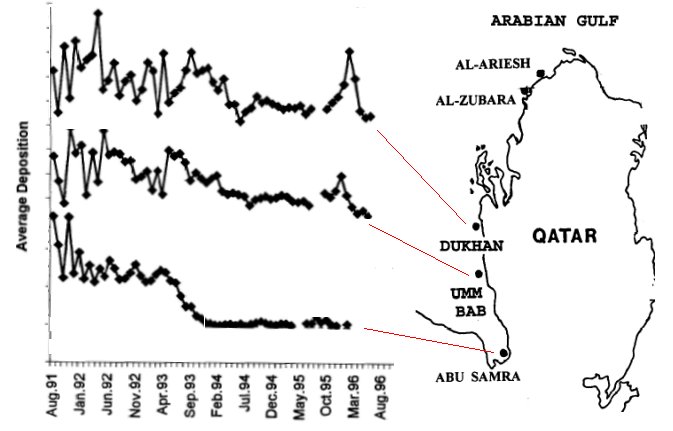 |
| Tar ball accumulation on the Qatari coast, from [ref]. Note: data arbitrarily offset for clarity. |
I did find one internet reference to a possible spill in 1993. At an oil spill workshop and exercise (date unknown), a manager for Bapco, the Bahraini national oil company, said something interesting:
Mr. Al-Ansari addressed the participants in the closing ceremony and stressed the importance of time when responding to oil spills.
He added that when he was Incident Commander in 1993 a large oil spill hit Jeddah Island and if the response then had been five hours sooner, 45% of the overall costs associated with responding to the oil spill would have been saved.
Jeddah is a small island located between Saudi Arabia and Bahrain, looking something like a posh retreat. It remains to be explained what qualifies as a "large oil spill", but it is something. Given Bahrain's close relationship with the rulers of Saudi Arabia, it's likely that no official protest was lodged.
Given the above, it is likely that an oil spill occurred in the Arabian Gulf in 1993. Would the effects from a massive spill be expected to be more pronounced?
In 1980, a blowout at an offshore well in Saudi Aramco's Hasbah field spewed oil for 8 days, for a total of 100,000 barrels. However, the Qatari coastline was affected for months. Hasbah is located southeast of the Zuluf field. Even though it was claimed that 85% of the oil from the purported spill was collected, the first few days (before significant oil collection could have occurred) would have been several times 100,000 barrels, and would have spread over such a wide area that going unnoticed seems unfathomable.
Lastly, we can look at Saudi Aramco's activities subsequent to this. They have been quite active in coordinated spill response drills and workshops. Here is one particular document which discusses many issues:
Saudi Aramco Oil Spill Approach, Prevention, and Readiness
In 1998, Saudi Aramco and the Petroleum Association of Japan (PAJ) conducted a joint exercise to test a coordinated response to a spill in the Arabian Gulf. PAJ had been working since 1991 to safeguard the transport of oil from the Middle East to Asia and had stockpiled oil spill remediation equipment at the Khafji oil field (shared with Kuwait) in 1994. The interesting facet is the description of the scenario given in the paper linked above:
The exercise scenario was developed by PAJ a consultant, Mr. Andrew Crawford of Water born Environmental Limited. The exercise scenario called for an oil spill involving a tank rupture in a Vela vessel during loading operations at Ju’aymah Terminal, which is located about 10 kilometers north of the main terminal at Ras Tanura. In addition, the scenario called for a hose rupture at the loading arm in the terminal, with the combined total amount of oil spilled coming to about 70,000 barrels. The resultant slick would then hit the shoreline and spread offshore near the main Ras Tanura Terminal. Ju’aymah has a major power generation plant at nearby Ghazlan, which would have to be notified to protect its water intake. The Ras Tanura Refinery water intake would also be affected. This amount of oil spillage is higher than the rated capability of Saudi Aramco's oil spill equipment in the Ras Tanura area.
Several questions come to mind here. First, was this really just Mr. Crawford's inspiration? If so, did the Saudi Aramco people present just sit there with poker faces? No mention is made of supertankers as cleanup tools either. But anyway, we have the beginnings for our movie plot. Perhaps Mr. Crawford would get a royalty check. Nick Pozzi...probably not.
Epilogue
Did this massive spill happen?
(cue the closing theme and credits...)


1 comment:
Post a Comment